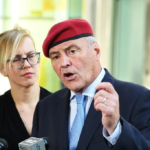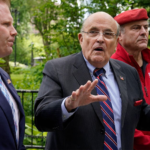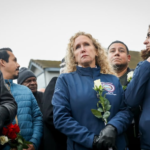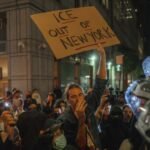
Shah J. Choudhury
NEW YORK, October 7: Two years ago today — on October 7, 2023 — Hamas launched a surprise attack on Israel that left nearly 1,200 people dead and hundreds taken hostage. The assault marked the beginning of one of the most violent and divisive conflicts in recent memory.
Now, two years later, New York City stands as a global stage for remembrance, protest, and prayer. Across the five boroughs, people are gathering to mourn, to demand peace, and to remind the world that the human cost of war still endures.
Vigils of Silence, Voices of Protest
All over the city, two parallel emotions define the day — grief and resistance.
At Columbia University, an installation of 1,200 empty chairs has drawn crowds since morning. Each chair bears the name and photo of a victim — a haunting symbol of lives lost and peace unfinished.
“This is not just about mourning,” said one student. “These chairs are a call for humanity.”
Meanwhile, in streets from Times Square to Brooklyn Bridge, demonstrators have taken to the streets demanding an end to the Gaza war.
Placards read “Ceasefire Now,” “Stop the War,” and “Justice for Gaza.”
Songs, slogans, and tears mingle as two truths coexist — Israeli families remembering their dead, and Palestinian voices crying for survival.
NYPD on High Alert
The New York Police Department (NYPD) has ramped up security across key locations including Times Square, Union Square, the United Nations headquarters, and major bridges.
Drone surveillance, counterterrorism units, and special patrols have been deployed to ensure public safety.
Police Commissioner Edward Caban stated:
“We want this day to be remembered for compassion, not chaos. Everyone has the right to mourn and speak freely — safely.”
Faith Leaders Call for Coexistence and Compassion
In mosques and synagogues across the city, the air is filled with prayers — for peace, for mercy, for an end to violence.
At a Brooklyn mosque, an imam led a special prayer for the children of Gaza:
“May God end the suffering of innocents, wherever they live.”
Across the East River, a Manhattan rabbi echoed the same sentiment:
“We share the same grief. The path forward must be empathy, not hatred.”
Global Context and Renewed Diplomacy
Even as vigils and protests unfold, the geopolitical crisis continues.
In Cairo, new mediation efforts are underway between Israel and Hamas, led by the United States, Egypt, and Qatar. The discussions focus on a potential prisoner exchange, humanitarian access, and partial troop withdrawal from Gaza.
Israeli Prime Minister Benjamin Netanyahu remarked: “Peace is possible, but not at the expense of our security.”
A Hamas spokesperson responded: “Peace cannot be built on the graves of Gaza’s children.”
According to the United Nations, over 33,000 people have been killed in Gaza since the conflict began — the majority women and children — deepening what the world body calls a “humanitarian catastrophe.”
A City Torn Between Two Sorrows
In New York, Israeli and Palestinian families often live side by side — yet today, grief divides them.
An Israeli mother attending a vigil said:
“My son won’t come back, but I pray no other mother buries her child.”
Moments later, a Palestinian student nearby said softly: “We’re not against anyone. We just want the world to let us live.”
Conclusion: The Echo of Humanity
Two years on, the shadow of October 7 still stretches across continents.
For New York — a city of immigrants, survivors, and dreamers — today is more than a remembrance. It is a reminder that the cost of war is always borne by the innocent, and the only victory that endures is the triumph of compassion.
War leaves wounds that time cannot heal,
but peace — even whispered — can still save a soul.







